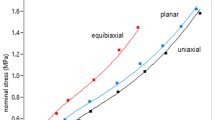Summary
The shape of the load-elongation curve and the temperature coefficient of the elastic modulus have been examined for the unidirectional extension of cross-linked gelatin films swollen in an alcohol-water mixture. The load-elongation curve for extensions up to 300% was of the form predicted by the kinetic theory of elasticity. The temperature coefficient of the stress at constant extension was positive and over the temperature range 50° to 70°C was proportional to absolute temperature. Between 50°C and 0°C the temperature coefficient of the stress was much greater. Over this temperature range the elastic modulus, as measured by extending a film at different temperatures, increased greatly as the temperature was lowered. It is suggested that the large temperature coefficient of the stress at temperatures below 50 °C is due to the formation of gelling cross-links causing straightening of the gelatin chains.
Zusammenfassung
Die Form der Spannungs-Dehnungskurve und der Temperaturkoeffizient des Elastizitätsmoduls wurde für lineare Streckung von vernetzten Gelatine-Filmen bestimmt, die in Alkohol-Wasser-Mischungen gequollen waren. Bis zu einer Dehnung von 300% hatte die Kurve die aus der kinetischen Elastizitätstheorie zu erwartende Form. Der Temperaturkoeffizient der Spannung für konstante Dehnung war positiv und im Temperaturbereich 50–70° C proportional der absoluten Temperatur; zwischen 0 und 50° C war er viel größer. In diesem Temperaturbereich vergrößert sich der Elastizitätsmodul, gemessen durch Dehnung des Films bei verschiedenen Temperaturen, beträchtlich mit sinkender Temperatur. Es wird angenommen, daß der große Temperaturkoeffizient der Spannung bei Temperaturen unterhalb 50° C auf die Bildung gelierender Querbindungen zurückzuführen ist, die die Gelatineketten ausrichten.
Similar content being viewed by others
References
Jopling, D. W., Bull. Brit. Soc. Rheol. No.46, 2 (1956).
Treloar, L. R. G., Trans. Farad. Soc.39, 242 (1943).
Treloar, L. R. G., The Physics of Rubber Elasticity (London 1949).
Ferry, J. D., J. Amer. Chem. Soc.70, 2244 (1948).
Hastewell, L. J. andR. Roscoe, Brit. J. Appl. Phys.7, 441 (1956).
Saunders, P. R., andWard A. G., in: The Rheology of Elastomers (London 1958).
Treloar, L. R. G., Trans. Farad. Soc.40, 59 (1944).
Tobolsky, A. V., J. Phys. Chem.59, 575 (1955).
Author information
Authors and Affiliations
Additional information
Communication No. 1955 H from the Kodak Research Laboratories.
Rights and permissions
About this article
Cite this article
Jopling, D.W. A note on the rubber-like properties of gelatin. Rheol Acta 1, 133–137 (1958). https://doi.org/10.1007/BF01968854
Received:
Issue Date:
DOI: https://doi.org/10.1007/BF01968854




